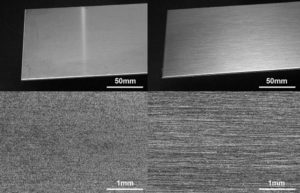The applied research urges the entrusted institutes to face relevant manufacturing issues; in the food ambit, for instance, daring surface treatments of stainless steel are increasingly demanded.

They are defined MOCA those materials and articles intended to come into contact with foods, such as kitchen and table tools, vessels and containers, machines for the food processing, packaging materials and so on. Since several of these objects are made from stainless steel sheet through cutting, bending or drawing processes, we have decided to interview a luminary in the sector, the Prof. Marco Boniardi, Professor of Metallurgy of the Engineering Department of Milan Polytechnics, who has worked for years at the theme of the finishing of stainless steel items intended for the contact with foods. «MOCA – he started explaining – are disciplined by European provisions through the EC Regulation n. 1935/2004, and on a national scale, by rules and decrees that have succeeded one another over the years, starting from the law on April 30th 1962, n. 283». Stainless steel is one of the materials more commonly used in the food industry; generally, it does not need any particular finishing treatment, being provided with a good resistance to corrosion in itself. A layer of chromium oxide, which protects the material itself, in fact, forms naturally on its surface. However, in certain applicative sectors, such as precisely the food ambit, the execution of additional treatments can improve and enhance such resistance features.
The added-value of electropolishing
Marco Boniardi explains: «The most severe requisites of MOCA must for instance include the “adequate” design, which means avoiding, for instance, manufactured goods with stagnation areas of products and liquids, and a high surface finishing degree. The latter characteristic, in particular, is very important since it grants a user-friendly cleaning of the good and scarce possibility that bacteria and other types of organisms are generated and proliferate on it. In the stainless steel case, the higher is the surface finish, the more homogenous and resistant is the oxide film». Due to that reason, the electropolishing is increasingly spreading, being a galvanic treatment that allow increasing the resistance to corrosion and granting a bright and reflecting surface to the treated components. Marco Boniardi: «The electropolishing can be applied to both items of daily use, like pots and crockery, and to the articles for the food stocking, such as silos and tanks and to the components contained in processing plants». Obviously, it is possible to obtain the same electropolishing roughness (Ra from 0.4 to 1.2 μm) through grinding but the mechanical removal of material generates residual surface stresses that speed up wear and degradation processes of the material. «The electropolishing, on the contrary, makes the surface smooth by removing roughness crests through an electrochemical process, in smooth and selective manner, which does not determine the appearance of residual stresses. Even if not very known, this characteristic makes such technology very interesting for applicative purposes». Marco Boniardi underlines then a particular theme: «In industry, they generally pay more attention to certain aspects. When instead components for domestic use are at stake, information and awareness about them decrease. I mean that often low-quality cutlery, pots and crockery are present in our kitchens, maybe imported from Countries that neglect certain matters. If the material or the treatment is of low quality, we risk the food contamination, i.e. ions of chrome, nickel and so on can end up inside foods. As our tests demonstrate».
Increase of hardness and of resistance to wear
There are, obviously, also some other types of treatments; for instance, those aiming at increasing the surface hardness, since the stainless steel is a material characterized by low hardness and scarce resistance to wear. «Concerning this, some big companies have developed innovative technologies indeed; to make an example, I mention Kolsterization ®. It is a technique of carbon diffusion on the surface, developed by Bodycote, which allows increasing the values of surface hardness without modifying the dimensional, finishing and resistance to corrosion properties of the material». In what cases do they use the treatments that increase hardness and resistance to wear? «Applications can be different. There are for instance dosing plants where foods are “handled” by means of organs that remind syringes, where a piston slides inside a cylinder. They are stainless steel components that need the increase of the resistance to wear to avoid the friction seizure. The rise of hardness and resistance to wear are on high demand also in the pharmaceutical, medical and military sectors». There are then other treatments of “surface modification”, like the casehardening, the nitriding and the ion implantation, even if they are more infrequent, since stainless steel is not the most suitable material for this typology of technologies. Marco Boniardi ends with a mention of his University: «It is necessary to specify that companies turn to Milan Polytechnics not for “base” but instead for “applied” researches. I mean that very often universities and research centres must face real, practical and productive issues: use conditions of machines, performance increase, reduction of criticalities and so on».
[su_slider source=”media: 8577,8575,8574,8576″]The presence of two adequately over-sized arms steadily holds the strip, granting utmost safety[/su_slider]



